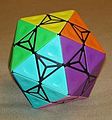Dogic facts for kids
The Dogic is a super cool puzzle shaped like an icosahedron, which is a shape with 20 flat sides. It's a bit like a Rubik's Cube, but much bigger and more complex! Instead of just a few pieces, the Dogic has 80 parts that you can move around. That's a lot more than the 20 pieces on a standard Rubik's Cube!
Contents
What is the Dogic Puzzle?
The Dogic puzzle is designed like an icosahedron, a shape with 20 triangle-shaped faces. It's cut into 60 small triangles around its 12 pointed tips and 20 center pieces. All these 80 pieces can slide and twist past each other. There are also hidden parts inside the puzzle that help keep it together as you twist it.
You can twist the Dogic in two main ways:
- Shallow Twist: This twist turns the 5 small triangles around one of the puzzle's tips. It moves these triangles between different faces but keeps them near the same tip.
- Deep Twist: This twist is bigger! It turns 5 whole faces (including the triangles) around a tip. This moves the triangles to different tips, but they stay on the same faces.
Each small triangle piece has one color. The center pieces can have one, two, or even three colors, depending on how the puzzle is designed.
How to Solve the Dogic
Solving a Dogic puzzle can be tricky, and the way you solve it depends on which version you have.
Solving the 12-Color Dogic
The 12-color Dogic is the most challenging version. In this puzzle, each of the 12 faces has a unique color, and the center pieces must match the colors of the faces next to them. The small triangle pieces then need to match the colors of their nearby center pieces.
The center pieces of the 12-color Dogic are similar to the corner pieces on a Megaminx puzzle. This means you can use some of the same solving steps you might use for a Megaminx. Once the center pieces are in the right spot, the triangles are usually easier to solve. This is because the 5 triangles around each tip are all the same color, so you can swap them around freely.
Solving the 10-Color Dogic
The 10-color Dogic is a bit less difficult than the 12-color version. This is because there isn't just one "solved" look. You can arrange the center pieces in many ways, and the puzzle will still look complete. However, many people like to arrange them in a neat way, like pairing up faces of the same color.
The triangles on the 10-color Dogic can be a little harder to solve than on the 12-color version. This is because the triangles next to each other in the solved state are not the same color, so you can't just swap them around as easily.
Solving Simpler Dogic Puzzles
There are also 5-color and 2-color Dogic puzzles. These versions are even easier to solve because they have many pieces that look exactly alike. These simpler Dogics are great for puzzle fans who are still learning and want to try a Dogic before tackling the super complex 12-color version.
How Many Ways Can a Dogic Be Mixed Up?
Because the different Dogic puzzles have different numbers of pieces that look the same, they each have a different number of possible combinations. There are 60 tip pieces and 20 center pieces, which can be arranged in a huge number of ways!
Combinations for the 12-Color Dogic
The 12-color Dogic has an incredibly large number of possible combinations. This is because:
- Only certain ways of swapping the center pieces are allowed.
- The way 19 of the center pieces are turned decides how the last one must be turned.
- Some of the small tip pieces look exactly the same.
- The puzzle doesn't have a fixed "top" or "bottom," so rotating the whole puzzle doesn't count as a new combination.
All these factors mean the 12-color Dogic can be in about 2.20 followed by 82 zeros (that's a really, really big number!) different positions.
Combinations for the 10-Color Dogic
The 10-color Dogic also has a huge number of combinations, but fewer than the 12-color version. Here's why:
- Like the 12-color version, only certain ways of swapping the center pieces are allowed.
- The way the center pieces are turned doesn't matter as much for solving.
- Ten of the center pieces look exactly like the other ten.
- Some of the small tip pieces look exactly the same.
- Again, the puzzle doesn't have a fixed "top" or "bottom."
Because of these differences, the 10-color Dogic can be in about 4.40 followed by 66 zeros (still a super huge number!) different positions.
Images for kids
See also
 In Spanish: Dogic para niños
In Spanish: Dogic para niños




